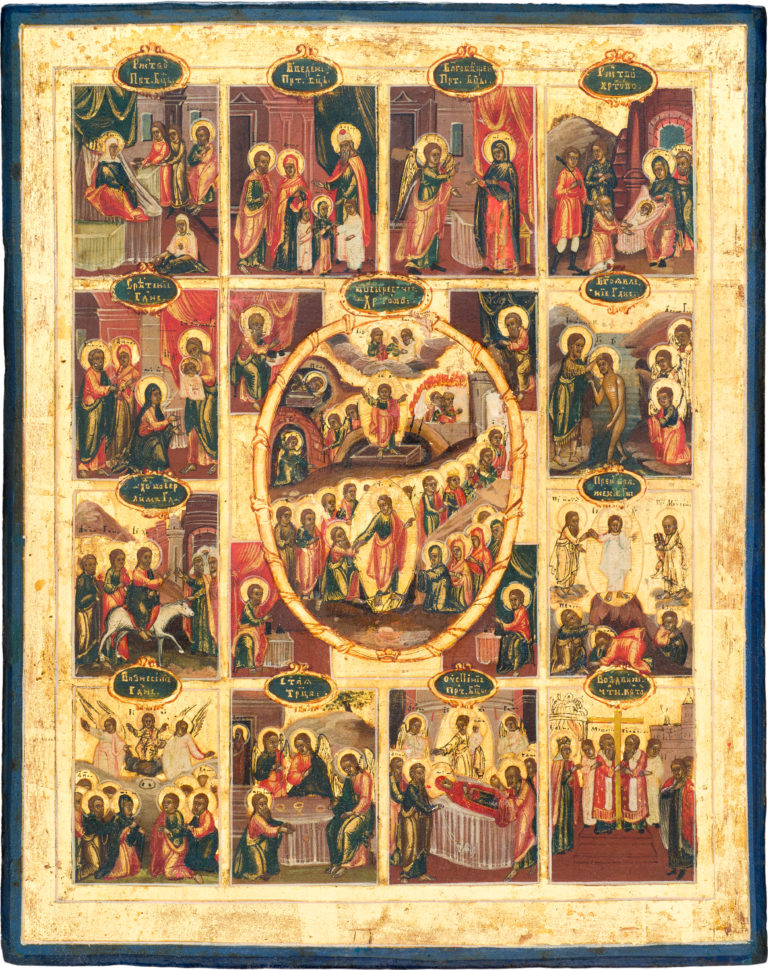The Resurrection—the Descent into Hell, with Church Feasts and the Four Evangelists in 12 Border Scenes
Antique Russian icon. Second half – end of the 19th century.
Size: 22 х 17.5 х 1.7 cm
Wood (one whole panel), no support boards or incut centerpiece, underlying layer of canvas is not visible, gesso, tempera.
The author’s paintwork is in an overall good state with only slight chafing and fallouts of paint, predominantly on the borders of the religious icon panel.
The reverse of the panel has several inscriptions: “№ 4196” made in pencil in the upper left corner; “Ф В” – to the right, in the center. In the left part, a nearly faded ink inscription made in three lines: “Ф / праз[ники] икону / [ ]я у[ ]ья.” In the center, there is also another faded pencil inscription.
Contact us

The Resurrection—the Descent into Hell, with Church Feasts and the Four Evangelists in 12 Border Scenes
Diagram of the border scenes:
Diagram of the border scenes:
- The Nativity of the Mother of God;
- The Entrance of the Mother of God into the Temple;
- The Annunciation;
- The Nativity of Christ;
- Candlemas (The Meeting of Christ in the Temple);
- The Theophany (The Baptism of Christ);
- The Entrance into Jerusalem;
- The Transfiguration;
- The Ascension;
- The Holy Trinity;
- The Dormition of the Mother of God;
- The Elevation of the Holy Cross.
Hand-painted Orthodox icons depicting the Resurrection – the Harrowing of Hades surrounded by the Twelve Great Feasts were incredibly popular in the 19th century. The popularity of such religious icon paintings is in many ways explained by the complexity of the composition, which included all the main Feasts of the liturgical year, with the main Feast – Pascha or the Resurrection of Christ – in the center. These hand-painted icons were often commissioned by churches. Large examples were considered temple icons, while smaller ones were placed on the analoion during Sunday services. Such pieces were also commissioned for private prayer. In folk culture, these religious icon paintings were seen as a type of agricultural calendar due to the fact that the main events of the natural cycle where closely linked with the liturgical calendar used by peasants. The demand on such hand-painted Orthodox icons led to their mass production, with various artists being ready to match the tastes and financial capabilities of all Russian social classes.
According to the traditional iconographic scheme, the religious icon centerpiece is occupied by the complex composition of the Resurrection of Christ, which includes the “Rising from the Tomb” scene. This variation was shaped in the 16th-century Russian icon art under the influence of Western European etchings. By the middle of the 17th century, the iconography became even more complex and began to include events that follow the Resurrection and predate the Ascension. With the “Rising from the Tomb” scene being placed in the upper tier, directly over the “Harrowing of Hades,” the composition is set on two centers placed along a single axis. This symbolic axis is further supplemented by the Holy Trinity (Enthronement) scene. The Resurrection, placed in an oval, is supplemented by the symbols of the Four Evangelists: John the Theologian, Matthew, Mark, and Luke.
The order of the religious icon border scenes begins with the Nativity of the Mother of God – the first main feast of the liturgical year (celebrated on September 8th by the Julian calendar). It is also worth noting that the Orthodox Church year begins on September 1st. Then the events (and border scenes) follow their historical chronology, which is explained by the fact that many of the feasts were moveable and, depending entirely on the date of Pascha, did not have a fixed day of their own. Despite the fact that the liturgical year ends with the Feast of the Dormition of the Mother of God (August 28th by the Julian calendar), the final scene in such Eastern Orthodox icons is usually the “Elevation of the Holy Cross” (September 28th by the Julian calendar). Thus, the religious icon encompasses the yearly liturgical cycle, eternally rotating around the main feast – Pascha.
The simplicity of the artistry, the likeness to folk art, and naive color scheme attest to the fact that the given antique icon was among those pieces painted by the millions and distributed all over Russia in the second half or end of the 19th century.